Revised 10 March 2022
Accepted 24 October 2022
Available Online 21 November 2022
- DOI
- https://doi.org/10.55060/s.atssh.221107.045
- Keywords
- Illustration elements of ancient books
Book design
Innovation
“Catalog of Marine Creatures” - Abstract
Book design was no longer a simple beautification work long ago. And book design directly affects reading experience of readers and is also an intuitive and highly generalized display of text content and cultural connotations. As a kind of visual language, illustration plays an extremely important role in book design. In the development process of Chinese books, the illustrations of ancient books in different historical periods have different styles. For today's society which demands pluralism, the illustration elements in ancient Chinese books can provide rich visual elements for modern book design. In addition, through the innovative application of illustration elements of ancient Chinese books in modern book design, works with more unique Chinese national characteristics and styles can be created. “Catalog of Marine Creatures” was a set of pictures of ancient marine creatures drawn by painter Nie Huang during the Kangxi Reign of the Qing Dynasty. There are a lot of illustration elements in the catalog. The organic integration of these illustration elements of ancient books and modern book design will help promote the development of China's book design with cultural characteristics.
- Copyright
- © 2022 The Authors. Published by Athena International Publishing B.V.
- Open Access
- This is an open access article distributed under the CC BY-NC 4.0 license (https://creativecommons.org/licenses/by-nc/4.0/).
1. INTRODUCTION
Book illustration is a strong visual symbol and an important way to visualize the text content of books. Book illustration elements can graphically convey the text content in a book through an intuitive visual image and further increase the interest of readers to read. Modern book design has developed rapidly. However, due to the lack of book design with both national characteristics and modern quality, there are many works drawing on foreign design styles in the existing book design markets, and book design lacks “Chinese characteristics” [1]. Illustration elements of ancient Chinese books are parts of traditional Chinese culture. The illustration elements in the books have the distinct characteristics of a specific era and the artistic conception of ancient Chinese literati. If the illustration elements of ancient Chinese books can be used in modern book design, there will be more works with Chinese artistic conception [2].
With the development of the times, people are more and more inclined to understand the world through images. Therefore, for modern book design, book illustration is not only an explanation of text content, but also an improvement of the artistic value of books. In the modern society with more and more developed science and technology, modern book design has higher requirements for information visualization. In the redesign of ancient Chinese books, it is necessary to retain the traditional style and characteristics, but also need to recreate in a novel and modern way to adapt to the appreciation of modern people.
2. OVERVIEW OF ILLUSTRATION ELEMENTS IN CHINESE ANCIENT BOOKS
Book illustration is an intuitive visual language and the role of book illustration in books is beyond doubt. The ancients attached great importance to the role of pictures when writing books and setting up theories. Considering the facts of “left picture and right text” and “left picture and right history” and the facts that “if there are not enough pictures, it is necessary to use the text to supplement [3]. If the picture is not complete, it is necessary to make description with the text”, it can be seen that ancient Chinese books have a good tradition of pictures and words complementing each other. If Chinese ancient books are divided by their production methods, they can be roughly divided into two types: hand-copied books and printed books. Therefore, ancient book illustration can also be roughly divided into freehand sketching and engraving pictures. It is now generally believed that illustrations in books appear at the same time as books. According to “The Book of Changes · Xici”, “there is He Tu and Luo Shu, and there are saints.” This is a description of the appearance of “He Tu Luo Shu”. Although there has been criticism on the authenticity of “He Tu Luo Shu”, the words described in “The Book of Changes · Xici” can also reflect the close relationship between pictures and books. As the carrier of recording information, some glyphs of inscriptions on bones or tortoise shells of the Shang Dynasty are generally considered to be pictographs. It can be seen that graphic elements and text elements are symbols for the ancients to record information. In the Han Dynasty, Cai Lun improved the paper after papermaking, which was not only conducive to writing, but also conducive to drawing, and also greatly increased the illustrative elements in books. In “the Book of Sui Dynasty · Jing Ji Zhi”, there were 14 volumes of “Zhou Guan Li Tu”, 2 volumes of “Jiao Si Tu” of Liang Dynasty, 9 volumes of “San Li Tu”, and 10 volumes of “Er Ya Tu”. And then, the wide range of application and large number of illustrations in ancient books can be seen. In the Ming and Qing Dynasties, illustration elements were widely used in novels, playing a supplementary role to text content, and improving the aesthetic value and appreciation value of illustration novels to a certain extent [4].
During the development of ancient book illustration, illustration types of Chinese ancient books can be roughly divided into decorative illustration, illustrative illustration and appreciative illustration. The purpose of decorative illustration is to beautify the form of books and arouse readers' interest in reading. Typical works include the Diamond Sutra from Dunhuang Sutra Grottoes, etc. The purpose of illustrative illustration is to visually transform the text content in a book, deepen the understanding of the text on the basis of meeting the aesthetic needs of readers, and making up for the shortcomings of the text content in order to achieve the purpose of knowledge dissemination. Most of these illustrations are used in ancient Chinese books such as books on agriculture, military, medicine, geography, astrology, etc. Typical works include the “Compendium of Materia Medica” compiled by Li Shizhen. Appreciative illustrations are often used in catalogs, novels, operas and other types of books. The purpose of appreciative illustration is to vividly express the rich content in the original work through illustrations and further increase the artistic appeal of the works. The content depicted is generally character modeling. Typical works include “A Dream in Red Mansions” in the Qing Dynasty and “Catalog of Marine Creatures” drawn by the painter Nie Huang in Qing Dynasty [5].
To sum up, illustration elements of Chinese ancient books are of strong adhesion and play a role in making the finishing point in the original work. At the same time, the illustration of Chinese ancient books has its unique characteristics, and the works perform the original views of the illustrator on the text content of the original work. For modern book design, it is more conducive to create the “Chinese style” of modern book design to refine and convert the illustration elements of Chinese ancient books. Applying the illustration elements of Chinese ancient books to modern book design is one way to activate Chinese traditional culture.
3. ANALYSIS ON THE CHARACTERISTICS OF ILLUSTRATION ELEMENTS IN “CATALOG OF MARINE CREATURES”
“Catalog of Marine Creatures” is a set of illustrations about ancient marine creatures painted by Nie Huang during the Kangxi Reign of the Qing Dynasty, including four volumes. The first three volumes are now in the Palace Museum in Beijing, and the fourth volume is now in the Palace Museum in Taipei [6]. In the book, Nie Huang recorded all kinds of creatures he saw and heard in the coastal areas of China in a combination of words and illustrations. The word “错” in “海错图” (“Catalog of Marine Creatures”) means “various kinds”, showing the number of marine creatures. As early as the Western Han Dynasty, Chinese people began to use “海错” to represent the marine creature. It can be seen from this that “Catalog of Marine Creatures” is actually a set of ancient marine creatures. With rigorous research spirit, Nie Huang traveled to the coastal areas of China and made a series of investigations on coastal creatures. He examined them by reading a large number of ancient books and documents and asking local fishermen. Since ancient times, few catalogs related to marine creatures had been circulated, and Nie Huang recorded what he saw and heard and drew a “Catalog of Marine Creatures” for future generations. Nie Huang finally completed the “Catalog of Marine Creatures” in the 37th year of Kangxi Reign (1698). However, Nie Huang himself had no intention of giving the book to the royal family. And the “Catalog of Marine Creatures” was brought into the palace by eunuch Su Peisheng in the fourth year of Yongzheng Reign (1726), was deeply loved by Emperor Qianlong, Emperor Jiaqing, Emperor Xuantong and so on, and once became their bedside reading materials.
Nie Huang described more than 300 kinds of creatures in “Catalog of Marine Creatures”, including invertebrates, vertebrates and many coastal plants [7]. Considering his own personal emotional factors, the biological image in the illustration elements of “Catalog of Marine Creatures” was created by Nie Huang through exaggerated freehand sketching based on field investigation. In addition to a large number of real marine creatures verified by experts, there were many legendary mysterious species, such as Mermaids and sharks. The illustration elements in “Catalog of Marine Creatures” show a distinctive personal style of the painter, which are of a certain reference value and significance for illustration in modern book design.
On the one hand, it can be seen from the illustration elements of some real marine creatures in “Catalog of Marine Creatures” that they tend to depict the original appearance of marine creatures in terms of shape and color. The Acipenser Sinensis (it is the Chinese sturgeon now) in “Catalog of Marine Creatures” is taken as an example for analysis. As the illustration elements in “Catalog of Marine Creatures” (Fig. 1) are compared with the real biological pictures (Fig. 2), it can be found that there is little difference between the shape in “Catalog of Marine Creatures” drawn by Nie Huang and the real object when creating the illustration. That is to say, Nie Huang followed the original color and shape of the real object when he drew the biological object. From this point of view, the purpose of catalog is to help people see more, and it is not a free creation completely divorced from reality.
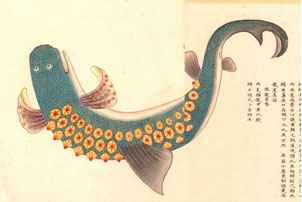
Illustration elements in the book (from [6], V2).
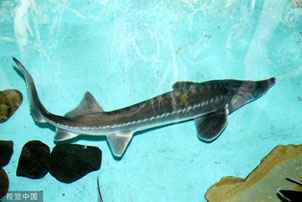
Picture of creatures shot in reality. From: Visual China Group (https://www.vcg.com).
On the other hand, Nie Huang's rich imagination can be seen in the illustration elements of some mysterious creatures in “Catalog of Marine Creatures”. The way he knew about the mysterious creatures was the oral account of local fishermen along the coast. Some mysterious creatures might not be seen by his own eyes. On this basis, he could only imagine the text content on the basis of summarizing the oral information and then creating illustrations. Therefore, the illustration elements of mysterious creatures in “Catalog of Marine Creatures” were bolder and had a strong personal style than real creatures in terms of modeling and color selection. This study takes Quzhuake dragon in “Catalog of Marine Creatures” as an example for analysis. Fig. 3 is the illustration of Quzhuake dragon in “Catalog of Marine Creatures”. The dragon has always been considered as a creature in Oriental mythology. According to Quzhuake dragon drew by Nie Huang, it was not difficult to find that he was influenced by the literature about the dragon in the past dynasties. To a certain extent, Nie Huang retained the basic characteristics, for example, “horns were like that of deer, heads were like that of that of cattle, eyes were like that of shrimp, mouth were like that of donkey, belly were like that of snake, scales were like that of fish, feet were like that of Phoenix, whiskers were like that of people, and ears were like that of elephants” (see left side of Fig. 3). At the same time, creative artistic processing was carried out on this basis, breaking through the original head shape that horns were like that of deer and heads were like that of that of cattle (see right side of Fig. 3). Therefore, this part of the illustration elements about mysterious creatures were created with the painter's own subjective initiative.
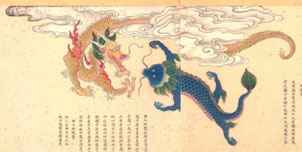
Illustration of Quzhuake dragon (from [6], Vol. 1).
In addition, a considerable part of the illustration elements in “Catalog of Marine Creatures” were created under the influence of the biological thought of the ancient theory of metamorphosis, such as the “deer fish turning into deer” (Fig. 4) and the “Zha fish turning into the gull” (Fig. 5) in “Catalog of Marine Creatures”. The ancients believed that there were four basic ways of reproduction of creatures, namely, vivipation, oviparity, Samsvedaja and metaplasia. Most of the metaplasia illustrations depicted in “Catalog of Marine Creatures” were about the transformation of one kind of creature into another kind of creature, which was very magical. At the same time, such illustration elements were also full of traditional Chinese ideology and culture, providing rich elements for the creation of modern book illustrations to a certain extent.

“Deer fish turns into deer” (from [6], Vol. 3).

“Zha” fish turns into seagull (from [6], Vol. 3).
4. INNOVATIVE APPLICATION OF THE THEME ILLUSTRATION OF “CATALOG OF MARINE CREATURES” IN MODERN BOOK DESIGN
In order to achieve the innovative application of the illustration elements of ancient Chinese books in modern book design, it is necessary to refine the traditional elements [8]. The image of the dragon redefined by Nie Huang in “Catalog of Marine Creatures” and the illustration elements in the book on the biological thought of ancient metaphysics are all image information that can provide rich material for modern book design. Adding illustration elements of ancient Chinese books to the design of modern books can promote the activation of traditional Chinese culture and arouse people's interest in traditional Chinese culture [8]. In the design of the modern book “Catalog of Interesting Marine Creatures”, the author selected ten representative illustrations after careful reading of “Catalog of Marine Creatures” and made new interpretations. The ten illustrations are “Perch”, “Well Fish”, “Olecranon Turtle”, “Hammockhead Shark”, “Dragon Shark”, “Plum Blossom Shark”, “Deer Fish Transformation into Deer”, “Zha Fish Transformation into Seagull”, “Quzhuake Dragon” and “Mirage”, of which there are six real species, including “Perch”, “Well Fish”, “Olecranon Turtle”, “Hammockhead Shark”, “Dragon Shark”, “Plum Blossom Shark”; there are two kinds on metaplasia, such as “deer fish transformation into deer” and “Zha fish transformation into seagull”; and there are the mysterious species, such as “Quzhuake dragon” and “mirage”. To a certain extent, these ten different types of illustrations condense the essence of the illustration elements in “Catalog of Marine Creatures”, which can make the original illustrations of “Catalog of Marine Creatures” fully reflect in the limited space of “Catalog of Interesting Marine Creatures”. The original illustration elements in “Catalog of Marine Creatures” are mainly represented by “face”. The picture is composed of different color blocks. The whole illustration presents the “literary atmosphere” of the Ming and Qing Dynasties. The overall tone is gray, showing a unique characteristic. Therefore, it is of a very high ornamental value at that time and even now. In contrast, after drawing on the illustration elements in the original work, the author tries to recreate ten selected illustrations in an illustration style that conforms to modern aesthetics. The overall illustration style focuses on “line”, and the picture is created with lines. In terms of color, the sharpness is adjusted according to the color in the original work, so that the color is more saturated, and the contrast of the picture is enhanced, in order to improve the visual impact of the illustration. As shown in Fig. 6 and Fig. 7, the illustrations of “Zha Fish Transformation into Seagull” and “Plum Blossom Shark” use the black as the background color to avoid visual confusion caused by bright colors, soften an image with contrasting colors, and ensure the unity of the overall book illustration elements at the same time. The thickness of the lines and the light and shade of the colors in the picture create a sense of space and primary and secondary of the picture, and the subject color and the background color of the picture are higher than the color saturation and brightness, in order to ensure that the main body of the illustration can be separated from the background image in the picture. And it has shown a visual sequence. On the basis of respecting the original illustrations in “Catalog of Marine Creatures”, it has injected new blood with the characteristics of the times in the process of innovative application to “Catalog of Interesting Marine Creatures”. It is hoped that through this innovative development and utilization of “Catalog of Marine Creatures”, more people pay attention to “Catalog of Marine Creatures”, and more people understand the mystery of excavating the elements hidden in the illustrations of ancient Chinese books, so that the excellent traditional symbols in ancient Chinese books can be innovatively transformed and developed. And then, it is feasible to promote the “activation” of China's excellent traditional culture, and make the cultural relics collected in museums, the heritage displayed on the vast land, and the words written in ancient books come alive, and tell the story of China to the world.
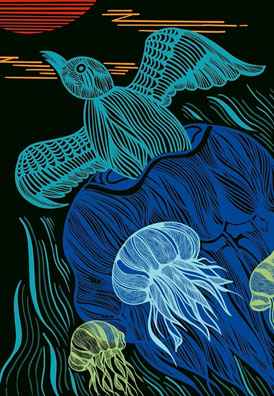
“Zha fish turning into the seagull”. Source: drawn by the authors.
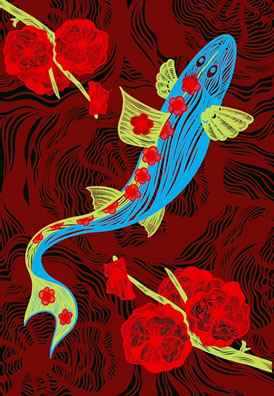
“Plum blossom shark”. Source: drawn by the authors.
5. CONCLUSION
Today, cultural self-confidence is advocated, and traditional Chinese culture is applied in various design fields. For book design, integrating traditional Chinese culture requires skillfully using traditional Chinese cultural elements in design rather than simply extracting patterns and making simple collages [9]. The illustration element of ancient Chinese books is a visual manifestation of traditional Chinese culture. Innovative application in modern books can activate the traditional culture behind it, so that more people pay attention to traditional culture. The application of Chinese ancient book illustration elements in modern book design can allow more books with “Chinese characteristics” and “Chinese quality” to appear [10].
REFERENCES
Cite This Article

TY - CONF AU - Yingying Pan AU - Yanjun Wang PY - 2022 DA - 2022/11/21 TI - Research on Innovative Application of Illustration Elements of Chinese Ancient Books in Modern Book Design: Taking “Catalog of Marine Creatures” as an Example BT - Proceedings of the 8th International Conference on Arts, Design and Contemporary Education (ICADCE 2022) PB - Athena Publishing SP - 295 EP - 300 SN - 2949-8937 UR - https://doi.org/10.55060/s.atssh.221107.045 DO - https://doi.org/10.55060/s.atssh.221107.045 ID - Pan2022 ER -









